制药工程专业英语
- 格式:ppt
- 大小:3.45 MB
- 文档页数:41

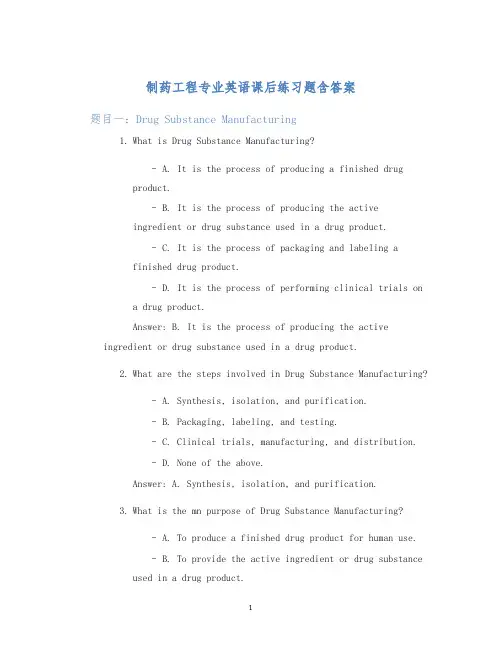
制药工程专业英语课后练习题含答案题目一:Drug Substance Manufacturing1.What is Drug Substance Manufacturing?–A. It is the process of producing a finished drug product.–B. It is the process of producing the activeingredient or drug substance used in a drug product.–C. It is the process of packaging and labeling a finished drug product.–D. It is the process of performing clinical trials ona drug product.Answer: B. It is the process of producing the active ingredient or drug substance used in a drug product.2.What are the steps involved in Drug Substance Manufacturing?–A. Synthesis, isolation, and purification.–B. Packaging, labeling, and testing.–C. Clinical trials, manufacturing, and distribution.–D. None of the above.Answer: A. Synthesis, isolation, and purification.3.What is the mn purpose of Drug Substance Manufacturing?–A. To produce a finished drug product for human use.–B. To provide the active ingredient or drug substance used in a drug product.–C. To test and validate the safety and efficacy of a drug product.–D. To distribute a drug product to consumers.Answer: B. To provide the active ingredient or drug substance used in a drug product.题目二:Pharmaceutical Formulation1.What is Pharmaceutical Formulation?–A. It is the process of producing a finished drug product.–B. It is the process of selecting and combining ingredients to produce a drug product.–C. It is the process of packaging and labeling a finished drug product.–D. It is the process of performing clinical trials ona drug product.Answer: B. It is the process of selecting and combining ingredients to produce a drug product.2.What are the key considerations in PharmaceuticalFormulation?–A. Safety, efficacy, and stability.–B. Cost, avlability, and taste.–C. Appearance, texture, and smell.–D. None of the above.Answer: A. Safety, efficacy, and stability.3.What is the role of excipients in Pharmaceutical Formulation?–A. They are the active ingredients in a drug product.–B. They are the inactive ingredients in a drug product that help to improve its properties.–C. They are the ingredients in a drug product that are responsible for the color and flavor.–D. None of the above.Answer: B. They are the inactive ingredients in a drug product that help to improve its properties.题目三:Good Manufacturing Practice (GMP)1.What is Good Manufacturing Practice (GMP)?–A. It is a set of regulations and guidelines that ensure the quality and safety of pharmaceutical products.–B. It is a set of regulations and guidelines that ensure the efficacy of pharmaceutical products.–C. It is a set of regulations and guidelines that ensure the affordability of pharmaceutical products.–D. None of the above.Answer: A. It is a set of regulations and guidelines that ensure the quality and safety of pharmaceutical products.2.What are the key components of Good Manufacturing Practice(GMP)?–A. Quality control, documentation, and facility design.–B. Clinical trials, manufacturing, and distribution.–C. Cost control, inventory management, and customer service.–D. None of the above.Answer: A. Quality control, documentation, and facility design.3.Why is Good Manufacturing Practice (GMP) important?–A. It helps to ensure the quality and safety ofpharmaceutical products.–B. It helps to reduce the cost of producingpharmaceutical products.–C. It helps to increase the avlability ofpharmaceutical products.–D. None of the above.Answer: A. It helps to ensure the quality and safety of pharmaceutical products.总结本文介绍了制药工程专业英语中的几个重要概念和术语,包括Drug Substance Manufacturing(药品物质制造)、Pharmaceutical Formulation(制剂开发)以及Good Manufacturing Practice(良好生产规范)。

制药工程专业英语详细Unit..详细翻译————————————————————————————————作者:————————————————————————————————日期:Unit 1 Production of Drugs根据其生产或来源不同药物制剂可以分为三类:Ⅰ.人工合成材料(全合成材料)Ⅱ.天然产物,和Ⅲ.半合成天然产物(半合成药物)。
本书的重点是这些第一组和第三组化合物都是合成药物。
然而这并不意味着那些天然药物和其他药物就不重要。
他们可以作为很有价值的先导结构,并经常被用为重要合成药物的原料或中间体。
表1概述了获取药物制剂的不同方法。
Table 1 Possibilities for the preparation of drugs表1药物制备的可能性方法例子1.全合成75%以上的药物制剂都是全合成的(合成物)2.从天然产物中分离(天然产物)2.1植物生物碱;酶;强心甙;多聚糖;维生素E; 类固醇前体(薯蓣皂苷配基,谷甾醇);柠檬醛(中间产物维生素A,E,K)2.2动物器官酶;多肽;激素;胆酸;胆汁;胰岛素来自胰腺;血清和疫苗2.3其他来源胆固醇来自羊毛油;L-氨基酸来自角蛋白和明胶水解3.发酵抗生素; L -氨基酸,葡聚糖;对甾类有定向的修饰,例如11 -羟基化;胰岛素,干扰素,抗体,肽类激素,酶,疫苗生物碱化合物;半合成内酰胺类抗生素;甾类;人胰岛素4.天然产物的半合成修改(半合成药物)几种最初来自于天然原料有治疗意义天然产物如今用更有效也就是经济的全合成法制备。
这样的例子包括L-氨基酸,氯霉素,咖啡因,多巴胺,肾上腺素,左旋多巴,肽类激素,前列腺素,D -青霉胺,长春蔓胺,以及几乎所有的维生素。
在过去的几年里发酵(即微生物处理)变得极其重要。
通过现代技术和遗传选择的结果产生了高效能微生物突变株,发酵已成为广泛的底物(物质)都可以选择的一种方法。
真核微生物(酵母菌和霉菌)和原核微生物(单细胞细菌和放线菌)用于微生物。

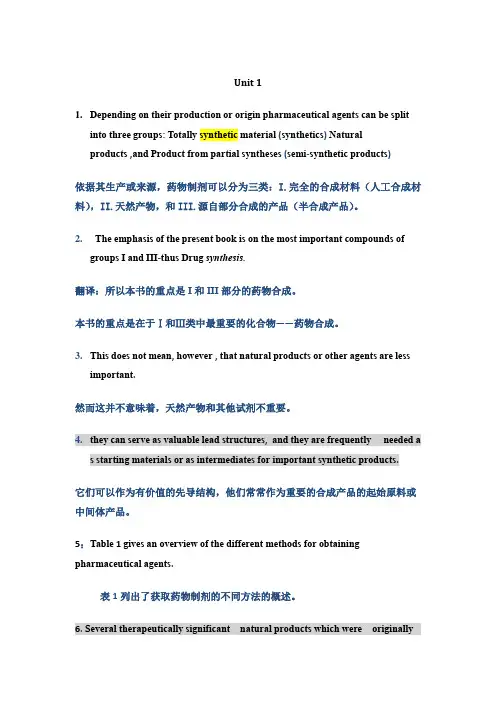
Unit 11.Depending on their production or origin pharmaceutical agents can be splitinto three groups: Totally synthetic material (synthetics) Naturalproducts ,and Product from partial syntheses (semi-synthetic products)依据其生产或来源,药物制剂可以分为三类:I.完全的合成材料(人工合成材料),II.天然产物,和III.源自部分合成的产品(半合成产品)。
2.The emphasis of the present book is on the most important compounds ofgroups I and III-thus Drug synthesis.翻译:所以本书的重点是I和III部分的药物合成。
本书的重点是在于Ⅰ和Ⅲ类中最重要的化合物——药物合成。
3.This does not mean, however , that natural products or other agents are lessimportant.然而这并不意味着,天然产物和其他试剂不重要。
4.they can serve as valuable lead structures,and they are frequently needed as starting materials or as intermediates for important synthetic products.它们可以作为有价值的先导结构,他们常常作为重要的合成产品的起始原料或中间体产品。
5:Table1gives an overview of the different methods for obtaining pharmaceutical agents.表1列出了获取药物制剂的不同方法的概述。
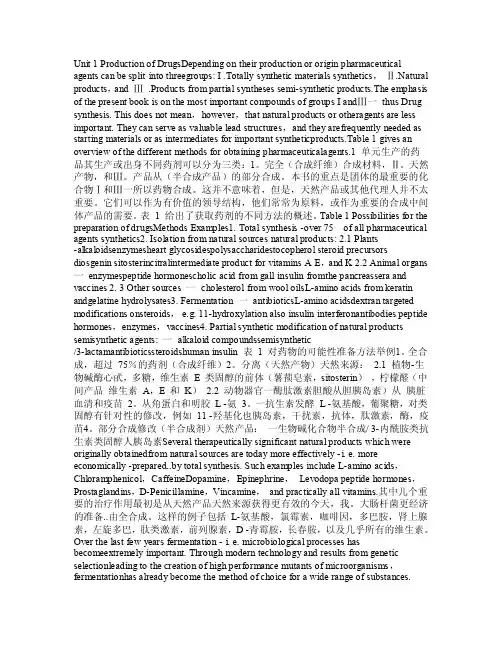
Unit 1 Production of DrugsDepending on their production or origin pharmaceutical agents can be split into threegroups: I .Totally synthetic materials synthetics,Ⅱ.Natural products,and Ⅲ.Products from partial syntheses semi-synthetic products.The emphasis of the present book is on the most important compounds of groups I andⅢ一thus Drug synthesis. This does not mean,however,that natural products or otheragents are less important. They can serve as valuable lead structures,and they arefrequently needed as starting materials or as intermediates for important syntheticproducts.Table 1 gives an overview of the different methods for obtaining pharmaceuticalagents.1 单元生产的药品其生产或出身不同药剂可以分为三类:1。
完全(合成纤维)合成材料,Ⅱ。
天然产物,和Ⅲ。
产品从(半合成产品)的部分合成。
本书的重点是团体的最重要的化合物Ⅰ和Ⅲ一所以药物合成。
这并不意味着,但是,天然产品或其他代理人并不太重要。
它们可以作为有价值的领导结构,他们常常为原料,或作为重要的合成中间体产品的需要。
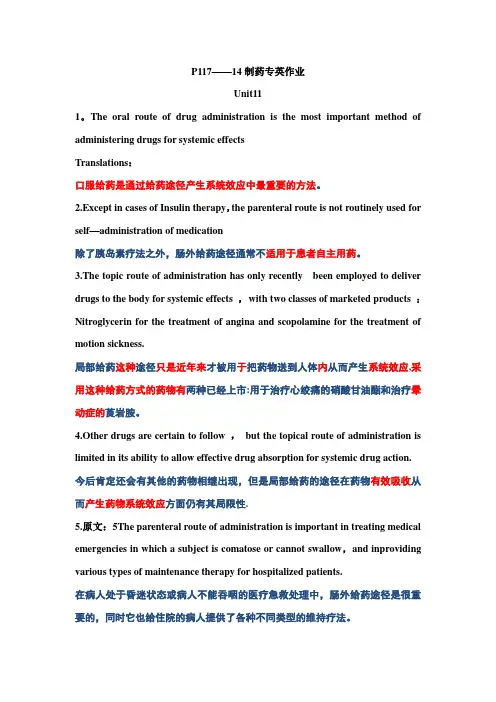
P117——14制药专英作业Unit111。
The oral route of drug administration is the most important method of administering drugs for systemic effectsTranslations:口服给药是通过给药途径产生系统效应中最重要的方法。
2.Except in cases of Insulin therapy,the parenteral route is not routinely used for self—administration of medication除了胰岛素疗法之外,肠外给药途径通常不适用于患者自主用药。
3.The topic route of administration has only recently been employed to deliver drugs to the body for systemic effects ,with two classes of marketed products :Nitroglycerin for the treatment of angina and scopolamine for the treatment of motion sickness.局部给药这种途径只是近年来才被用于把药物送到人体内从而产生系统效应,采用这种给药方式的药物有两种已经上市:用于治疗心绞痛的硝酸甘油酯和治疗晕动症的莨岩胺。
4.Other drugs are certain to follow ,but the topical route of administration is limited in its ability to allow effective drug absorption for systemic drug action.今后肯定还会有其他的药物相继出现,但是局部给药的途径在药物有效吸收从而产生药物系统效应方面仍有其局限性.5.原文:5The parenteral route of administration is important in treating medical emergencies in which a subject is comatose or cannot swallow,and inproviding various types of maintenance therapy for hospitalized patients.在病人处于昏迷状态或病人不能吞咽的医疗急救处理中,肠外给药途径是很重要的,同时它也给住院的病人提供了各种不同类型的维持疗法。
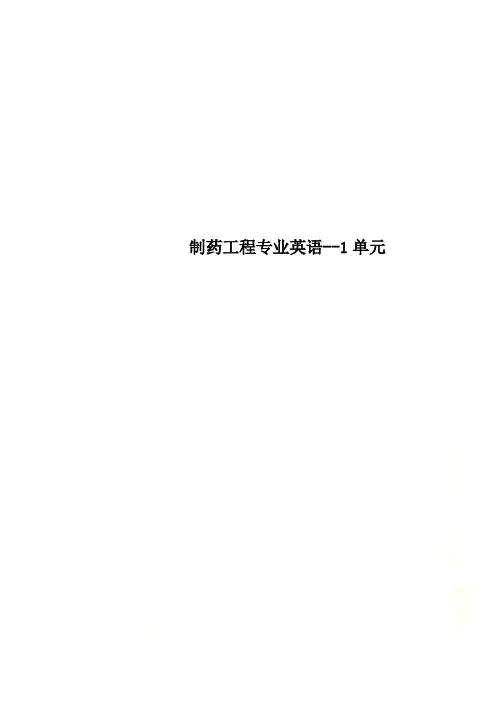
制药工程专业英语--1单元Unit 11.Depending on their production or origin pharmaceutical agents can be splitinto three groups: Totally synthetic material (synthetics) Naturalproducts ,and Product from partial syntheses (semi-synthetic products)依据其生产或来源,药物制剂可以分为三类:I.完全的合成材料(人工合成材料),II.天然产物,和III.源自部分合成的产品(半合成产品)。
2.The emphasis of the present book is on the most important compoundsof groups I and III-thus Drug synthesis.翻译:所以本书的重点是I和III部分的药物合成。
本书的重点是在于Ⅰ和Ⅲ类中最重要的化合物——药物合成。
3.This does not mean, however , that natural products or other agents areless important.然而这并不意味着,天然产物和其他试剂不重要。
4.they can serve as valuable lead structures, and they are frequently needed as starting materials or as intermediates fo r important synthetic products.它们可以作为有价值的先导结构,他们常常作为重要的合成产品的起始原料或中间体产品。
5:Table1gives an overview of the different methods for obtaining pharmaceutical agents.表1列出了获取药物制剂的不同方法的概述。
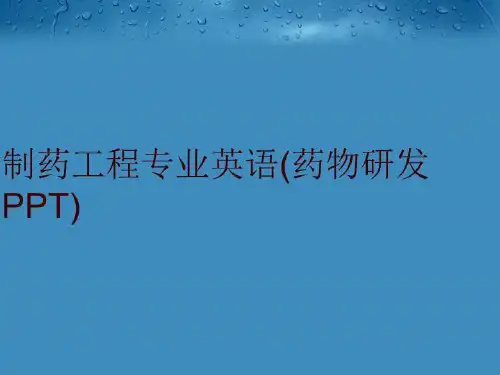
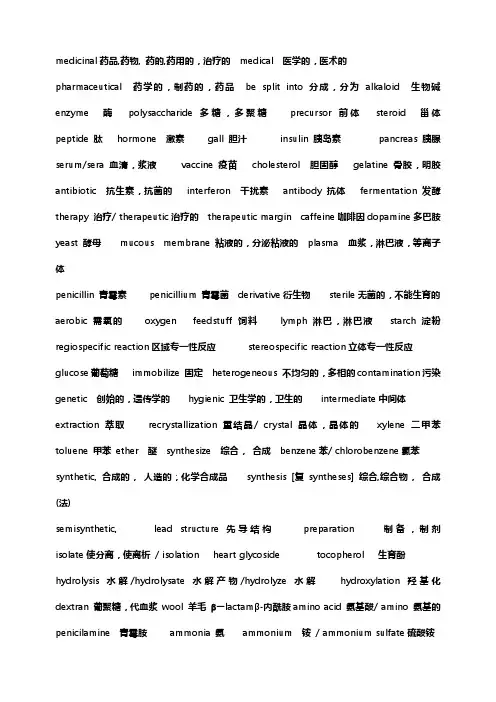
medicinal药品,药物, 药的,药用的,治疗的medical 医学的,医术的pharmaceutical 药学的,制药的,药品be split into 分成,分为alkaloid 生物碱enzyme 酶polysaccharide 多糖,多聚糖precursor 前体steroid甾体peptide 肽hormone 激素gall 胆汁insulin 胰岛素pancreas胰腺serum/sera血清,浆液vaccine 疫苗cholesterol 胆固醇gelatine 骨胶,明胶antibiotic 抗生素,抗菌的interferon 干扰素antibody 抗体fermentation 发酵therapy 治疗/ therapeutic治疗的therapeutic margin caffeine咖啡因dopamine多巴胺yeast 酵母mucous membrane粘液的,分泌粘液的plasma 血浆,淋巴液,等离子体penicillin 青霉素penicillium 青霉菌derivative衍生物sterile无菌的,不能生育的aerobic 需氧的oxygen feedstuff 饲料lymph淋巴,淋巴液starch 淀粉regiospecific reaction区域专一性反应stereospecific reaction立体专一性反应glucose葡萄糖immobilize 固定heterogeneous 不均匀的,多相的contamination污染genetic 创始的,遗传学的hygienic 卫生学的,卫生的intermediate中间体extraction 萃取recrystallization 重结晶/ crystal 晶体,晶体的xylene 二甲苯toluene 甲苯ether 醚synthesize 综合,合成benzene苯/ chlorobenzene氯苯synthetic, 合成的,人造的;化学合成品synthesis [复syntheses] 综合,综合物,合成(法)semisynthetic, lead structure先导结构preparation 制备,制剂isolate使分离,使离析/ isolation heart glycoside tocopherol 生育酚hydrolysis水解/hydrolysate水解产物/hydrolyze水解hydroxylation 羟基化dextran 葡聚糖,代血浆wool 羊毛 ーlactamβ-内酰胺amino acid 氨基酸/ amino 氨基的penicilamine 青霉胺ammonia 氨ammonium 铵/ ammonium sulfate硫酸铵amine 胺amide酰胺microorganism 微生物microbiological微生物学的mutant 变异的;突变型,突变体starting material 起始原料natural source天然来源organ器官/target organ 靶器官pancreas 胰腺natural product 天然产物mould 霉,霉菌;发霉high performance 高效bacterial 细菌的protein 蛋白质degradation 降解metabolism新陈代谢/ metabolize metabolite代谢物molecule /molecular weight food additive organiclactic acid乳酸citric acid 柠檬酸tetracycline 四环素carbon dioxide 二氧化碳carbohydrate 碳水化合物saccharide 糖/多糖polysaccharide nitrogen 氮urea 尿素phosphate 磷酸盐optimal 优化的,最佳的separate vt 分离absorption 吸收absorb vt. 吸收filtration 过滤filtrate 滤液filte 过滤(vt),过滤器(n)recombinant 重组的,重组子purification 纯化encode把(电文等)译成电码(或密码), 编码calcium 钙chromatographic procedure 色谱操作步骤isomerization异构化/isomeric phenol 酚fructose 果糖fumaric acid 富马酸countless test 非计数的diagnose诊断diagnostic analysis分析/analyze 分析vt / analyst分析家/ analytical分析的protease 蛋白酶Ingredient 成分in combination with 结合Digestion 消化。
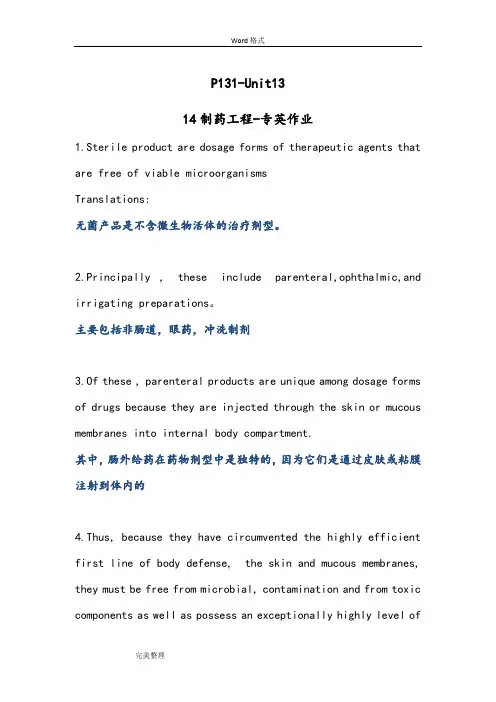
P131-Unit1314制药工程-专英作业1.Sterile product are dosage forms of therapeutic agents that are free of viable microorganismsTranslations:无菌产品是不含微生物活体的治疗剂型。
2.Principally,these include parenteral,ophthalmic,and irrigating preparations。
主要包括非肠道,眼药,冲洗制剂3.Of these , parenteral products are unique among dosage forms of drugs because they are injected through the skin or mucous membranes into internal body compartment.其中,肠外给药在药物剂型中是独特的,因为它们是通过皮肤或粘膜注射到体内的4.Thus, because they have circumvented the highly efficient first line of body defense, the skin and mucous membranes, they must be free from microbial, contamination and from toxic components as well as possess an exceptionally highly level ofpurity.因此,因为它们穿过了人体的第一道防线,皮肤和粘膜,所以它们必须没有微生物的污染和有毒成分,以及具有非常高的纯度水平。
5.原文:All compontents and processes involved in the preparation of these products must be selected and designed to eliminate,as much as possible, contamination of all types,whether of physical,chemical,or microbiologic origin. 翻译:在产品制备中涉及的所有组分和工艺流程必须要筛选和设计以尽可能消除各种类型的污染,无论是来自物理的,化学的,还是微生物的。
制药工程专业英语Chap7.1over three quarters of the world's population relies mainly onplants and plant extracts for health care.Approximately one third of the prescription drugs in the US contain plant components,and more than 120 important prescription drugs are derived from plants.Most of these drugs were developed because of their use in traditional medicine.Economically this represents $8000~10000M of annual consumer spending. Recent World Health Organization studies indicate that over 30 per cent of theworld's plant species have at one time or another been used for medicineal purposes. of the 250000 higher plant species on Earth, more than 80000 species are medicinal.Although traditional medicine is widespread throughout the world,it is an integral part of eachindividual culture. Its practice is based mainly on traditional beliefs handed down from generation to generation for hundreds or even thousands of years.Unfortunately,much of this ancient knowledge and many valuable plants are being lost at an alarming rate.the scientific study of traditional medicines and the systematic preservation of medicinal plants are thus of great importance.For quite a long time, the only way to use plant medicines waseither direct application or the use of crude plant extracts.With the development of organic chemistry at the beginning of thiscentury,extraction and fractionation techniques improvedsignificantly.It became possible to isolate and identify many of the active chemicals from plants.In the 1940s,advances in chemical synthesis enabled the synthesis of many plant components and their derivatives.In western countries, it was thought that chemical synthesis of drugs would be more effective and economical than isolation from naturalsources.indeed,this is true in many cases.however,in many othercases,synthetic analogues are not as effective as their natural counterparts.In addition,some synthetic drugs cost many times more than natural ones. 在世界上有四分之三的人口主要依靠植物和植物提取物的保健作用。